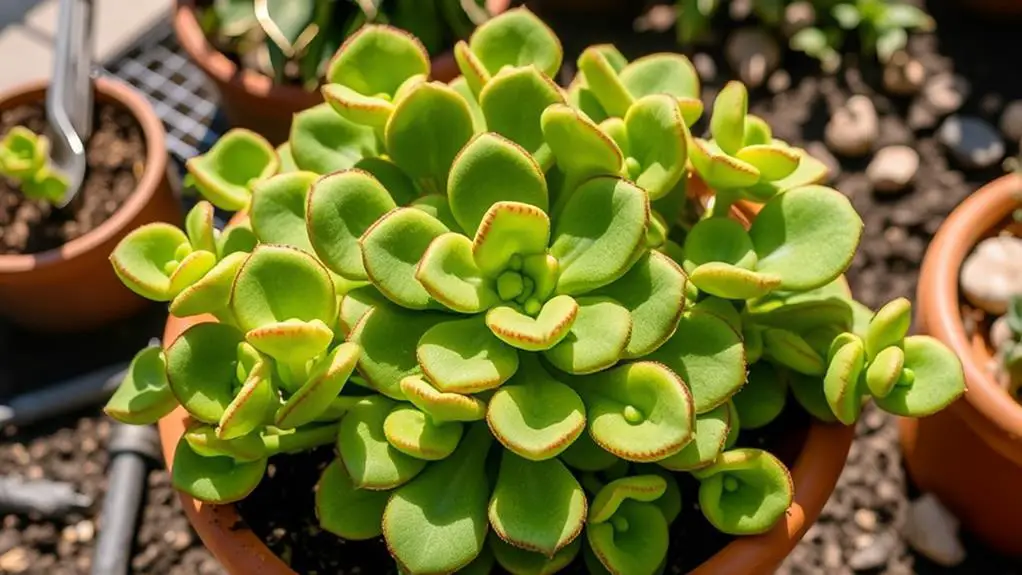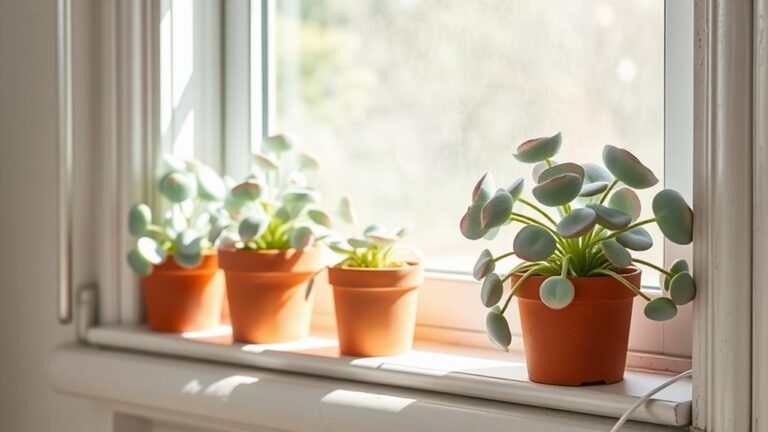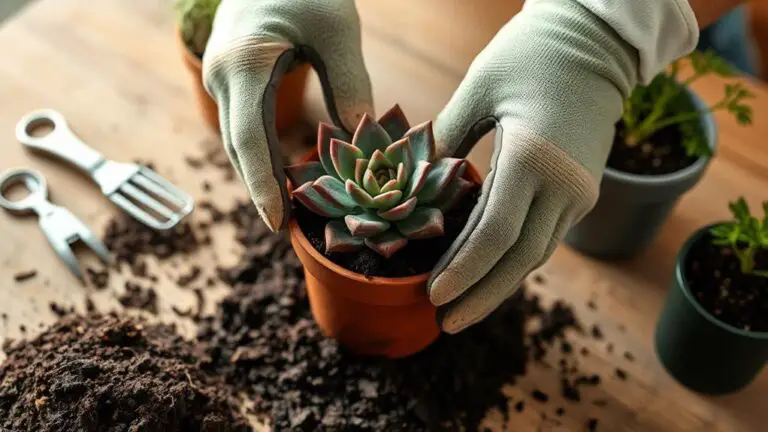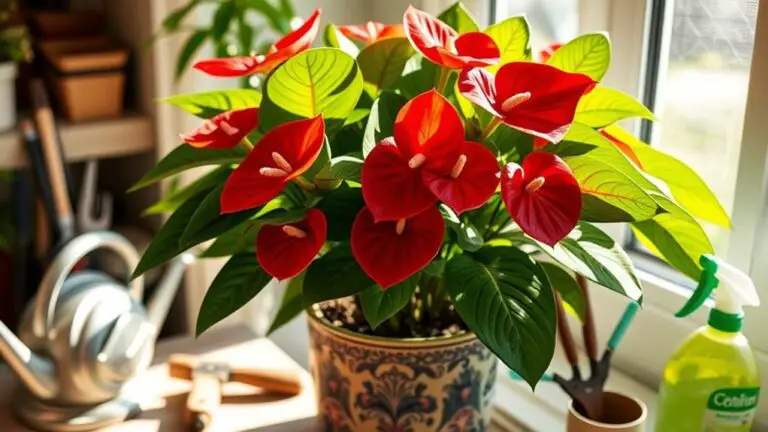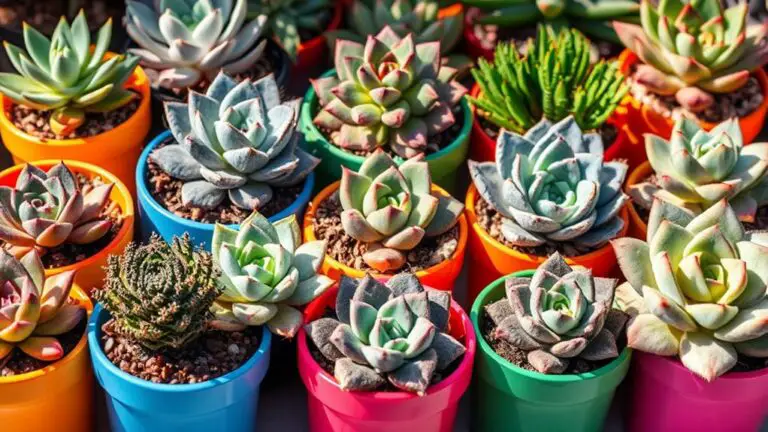Comprehensive Guide to Cotyledon Orbiculata Care
When you're caring for a Cotyledon orbiculata, understanding its unique needs is crucial to guarantee it thrives. This succulent loves bright, indirect sunlight and demands well-draining soil to prevent root rot. You'll need to adjust your watering routine with the seasons, always letting the topsoil dry out between sessions. Regular pruning keeps the plant healthy, and strategic fertilization every 4-6 weeks during its growing season can boost its liveliness. However, don't overlook the fact that this plant is toxic, posing risks to pets and children. Curious about the specifics of soil and potting, or how to handle common issues?
Toxicity and Safety
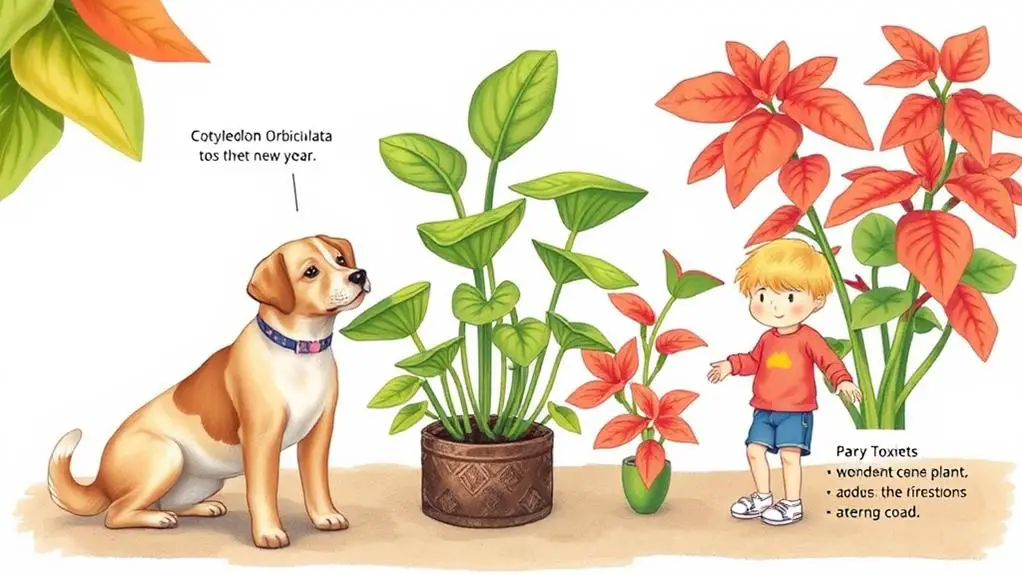
When it comes to Cotyledon orbiculata, guaranteeing the safety of your pets and family should be a top priority. This plant, while beautiful, is toxic to pets, particularly cats and dogs. If your furry friends accidentally ingest it, they may experience mild to moderate gastrointestinal symptoms. Common signs of toxicity include vomiting, diarrhea, and lethargy. In some cases, the reactions can be more severe.
The compounds in Cotyledon orbiculata can irritate the gastrointestinal tract, causing these unpleasant symptoms. To prevent accidental ingestion, make certain to keep this plant out of reach of both pets and children. Simple safety precautions, like placing the plant on high shelves or in rooms not accessible to pets, can make a big difference.
If you suspect your pet has ingested Cotyledon orbiculata, don't wait. Seek medical advice promptly to address potential symptoms of toxicity. Quick action can help manage the symptoms and guarantee your pet gets the care they need.
Keeping an eye on your pets and taking these precautions can help you enjoy your Cotyledon orbiculata safely and confidently.
General Care Requirements
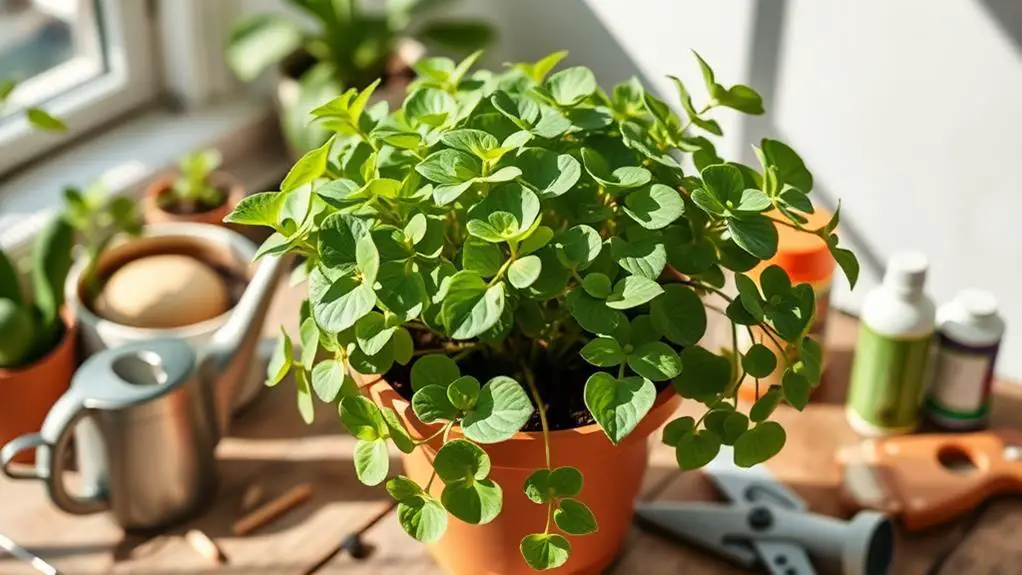
While ensuring the safety of your pets and family is important, you'll also want to provide the right care to keep your Cotyledon orbiculata healthy and thriving.
Cotyledons love bright, indirect sunlight and can handle some direct sunlight. However, be careful to protect them from the intense midday sun, which can cause leaf burn.
For soil, use a well-draining mix, ideally one formulated for succulents or cacti. This helps prevent root rot. Adding perlite or coarse sand can improve drainage further.
When it comes to watering, wait until the topsoil is dry to the touch. Water thoroughly but make sure it drains completely. In cooler months, reduce watering to avoid root rot.
Cotyledons prefer temperatures between 65°F and 75°F. They can handle cooler weather if kept dry, but frost is a big no-no.
To keep your plant happy, fertilize it sparingly during the growing season. A balanced, diluted liquid fertilizer every 4-6 weeks works well. Stop fertilizing in fall and winter when the plant's growth slows down.
Soil, Fertilizer, and Potting
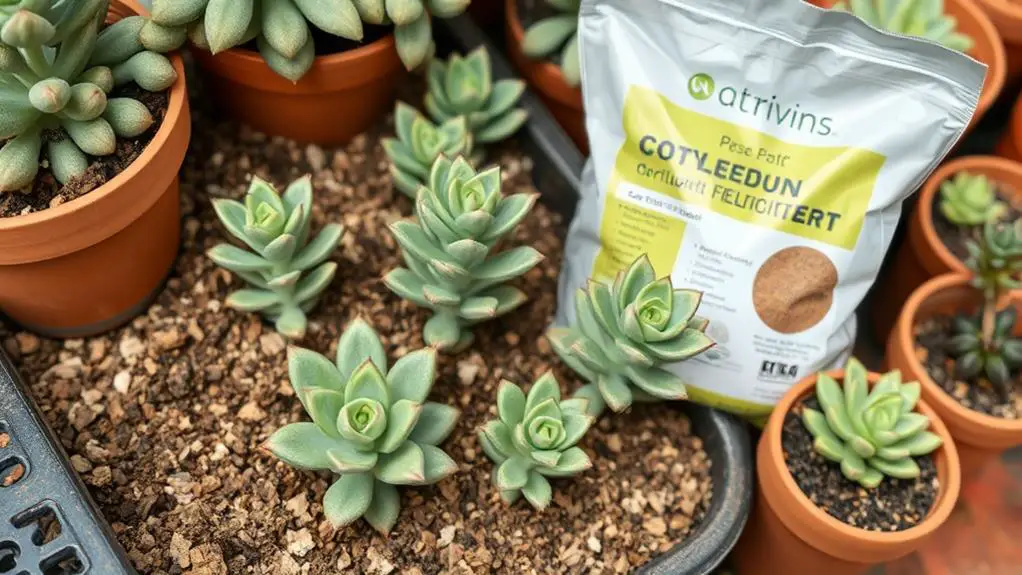
For ideal Cotyledon orbiculata care, focus on providing a well-draining soil mix specifically formulated for succulents or cacti. Add perlite or coarse sand to enhance drainage and prevent waterlogging. This guarantees the roots stay healthy and avoid rot.
When it comes to potting, choose a snug pot that allows for growth but has drainage holes to prevent excess moisture at the bottom.
Here's a quick guide:
- Soil: Use a mix designed for succulents, incorporating perlite or coarse sand.
- Pot: Select a pot with drainage holes to avoid water accumulation.
- Repotting: Do this every 2-3 years or when the plant becomes root-bound.
Fertilize sparingly. Apply a balanced, diluted liquid fertilizer every 4-6 weeks during the growing season. Hold off on fertilizing in fall and winter when the plant's growth slows. Over-fertilizing can harm root health.
Regularly check your soil's aeration and composition. Compacted soil can hinder root health and overall plant health.
Keeping the soil loose guarantees better growth and a healthier plant. So, always aim to maintain a well-draining and airy potting soil for your Cotyledon orbiculata. This will keep your plant thriving and looking its best.
Propagation, Pruning, and Blooming

To propagate Cotyledon orbiculata, you can use leaf cuttings or offsets. Start by taking healthy leaf cuttings and letting them callus for a few days. This step is essential to prevent rot. Once callused, plant them in well-draining succulent soil.
For offsets, carefully separate them from the parent plant, allow the cut ends to dry, and then plant them in a suitable soil mix. Both methods are simple and effective.
Pruning your Cotyledon orbiculata is straightforward. You only need to remove dead leaves or damaged foliage. This not only keeps your plant looking tidy but also encourages new growth.
Use clean, sharp tools to prevent spreading diseases. Don't worry; minimal pruning is all it takes to keep your plant healthy.
Blooming usually happens in late summer, with tall stems showcasing tubular flowers in stunning shades of orange, coral, or red. To promote blooming, make sure your plant gets adequate sunlight and proper care.
After blooming, it's a good idea to remove spent flowers. This helps the plant redirect its energy into new growth instead of seed production.
With these simple steps, your Cotyledon orbiculata will thrive!
Common Problems and Solutions
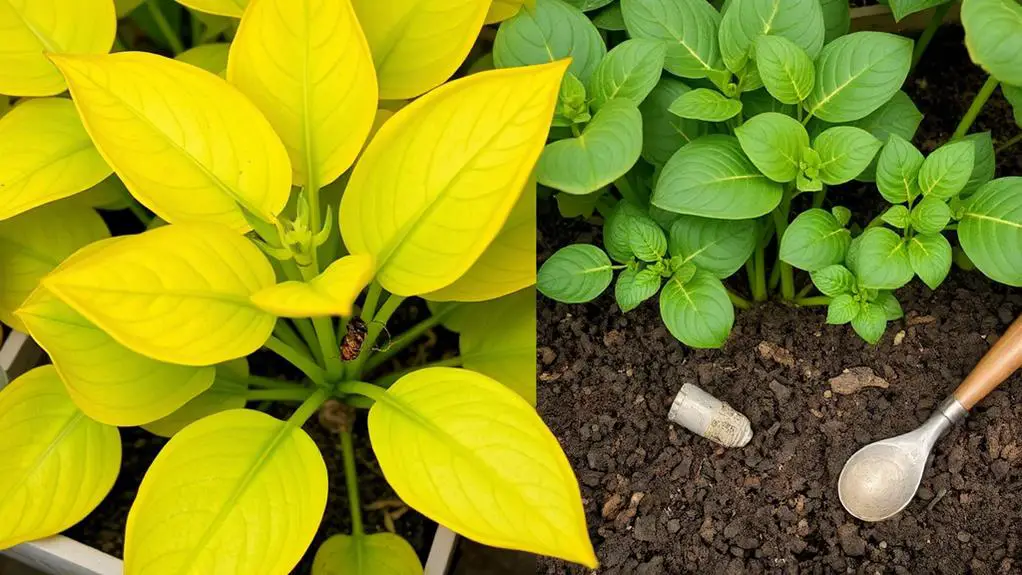
Caring for Cotyledon orbiculata can present a few common challenges, but knowing how to tackle them will keep your plant thriving.
Overwatering is a frequent problem, causing yellowing or rotting leaves. To avoid this, let the soil dry thoroughly between waterings. On the flip side, underwatering can make the leaves shrivel or wilt. During active growth, make sure to water more often.
Pests like aphids, mealybugs, and spider mites can invade your plants. Treat them with insecticidal soap or neem oil to protect plant health.
Remember, proper light intensity is key. Sudden exposure to strong sunlight can cause sunburn, while frost can lead to cold damage. Gradually acclimate your Cotyledon orbiculata to sunlight and shield it from cold temperatures.
Root rot is another concern, marked by brown, mushy roots. Prevent this by ensuring excellent soil drainage and being cautious with watering practices.
Here's a quick checklist for addressing common problems:
- Overwatering: Allow soil to dry thoroughly between waterings.
- Pests: Use insecticidal soap or neem oil to manage infestations.
- Sunburn and Cold Damage: Gradually acclimate to sunlight and protect from frost.
Frequently Asked Questions
How to Look After Cotyledon Orbiculata?
Place your Cotyledon orbiculata in bright, indirect sunlight. Water when the topsoil's dry, using well-draining soil. Fertilize every 4-6 weeks during growing season. Watch for pests and treat with insecticidal soap or neem oil.
How Do You Care for Cotyledon Orbiculata Ping Pong Plants?
Place your Cotyledon orbiculata ping pong plant in bright, indirect sunlight. Water every 10-14 days, using well-draining soil. Maintain temperatures between 65°F-75°F and low humidity. Fertilize sparingly during the growing season.
What Are the Brown Spots on My Cotyledon Orbiculata?
Brown spots on your Cotyledon orbiculata could be from sunburn, overwatering, fungal infections, nutrient deficiency, or pests. Gradually acclimate to sunlight, adjust watering, guarantee airflow, fertilize properly, and inspect for pests to resolve this issue.
How to Prune Cotyledon Orbiculata?
To prune your Cotyledon orbiculata, remove dead or damaged leaves with clean, sharp tools. Prune during late spring or early summer, making clean cuts at the leaf base. Regularly inspect for stress, and provide ideal care post-pruning.
Conclusion
You've got this! Caring for your Cotyledon orbiculata is all about creating the right environment and paying attention to its needs. With bright, indirect sunlight, well-draining soil, and proper watering, your plant will thrive. Don't forget to prune regularly and fertilize during the growing season. Keep it safe from pets and kids, and you'll enjoy a healthy, beautiful succulent. Remember, a little effort goes a long way in making your garden flourish!

